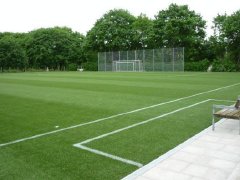The Hans Walter Wild Stadium belonging to the German regional soccer team Spielvereinigung Bayreuth has the first soccer pitch in Germany to feature artificial turf from the Swiss company XL Turf. Laid beneath the green turf fibers are several hundred slabs which are made from Neopolen P, the expanded polypropylene (EPP) from BASF. They act as a foam cushion which absorbs energy.
 The Hans Walter Wild Stadium belonging to the German regional soccer team Spielvereinigung Bayreuth has the first soccer pitch in Germany to feature artificial turf from the Swiss company XL Turf.
The Hans Walter Wild Stadium belonging to the German regional soccer team Spielvereinigung Bayreuth has the first soccer pitch in Germany to feature artificial turf from the Swiss company XL Turf.
The lightweight Neopolen P layer, which is twenty millimeters thick, is noted for its excellent resilience, thus increasing the playing comfort and preventing sports-related injuries. Thanks to its fiber structure and the elastic EPP support layer, the artificial turf is durable, easy to maintain and weatherproof. It meets the requirements of established standards and various European soccer associations.
Stable support layer which is gentle on the joints
The artificial turf contains up to seven times more fibers than conventional products and is four times denser. The near-natural resilience of the fibers is made possible by spiral-shaped additional fibers which act like springs. With each impact on the turf, the Neopolen P slabs, which measure roughly one square meter, absorb the energy and release it again after a short period of time, with the foam returning to its original shape. There are no permanent material deformations or fractures; the absorption properties are retained. The Neopolen P substrate also minimizes the strains on players' muscles and joints: The predominantly closed-cell, air-filled particles have a cushion factor of 2.6 to 2.8 based on test method ISO 4651 - this is deemed to be gentle on the joints in the human skeleton.
The XL artificial turf consists exclusively of plastic. It does without sand or rubber granules which are applied as a cushioning material on conventional artificial turf pitches. Like the cinder used on a tennis court, these granules lose their bounce properties over time, resulting in a deteriorating evenness of the pitch and therefore its playability - the granules then have to be cleaned, replenished or replaced. With XL Turf there is no need for this: if necessary, individual parts of slabs can be cut out and replaced. In contrast to rubber granules and the elastic support layer found in conventional artificial turf, XL Turf is 100% recyclable.
Easy to lay thanks to slab and track system
The turf is easy to look after and maintain, being vacuumed and brushed. The Neopolen P sub-layer can easily be cleaned or disinfected, it does not absorb water and is resistant to oils and chemicals. "Artificial turf like this which is not filled-in is ideal for amateur clubs," says Pascal Beerli, managing director of XL Turf and the joint developer of the turf. "The much lower care, maintenance and disposal costs compared with filled-in artificial turf reduce the costs for clubs and communities. This artificial turf is also perfect for large modern stadiums. High stands for spectators mean that less light gets onto the pitch and ventilation is poor. It is very expensive to maintain and look after natural turf here."
XL artificial turf consists of prefabricated Neopolen P slabs and artificial turf tracks. The lightweight slabs, which are shaped like the pieces of a puzzle, can be laid in a few days. Artificial turf tracks which are four meters wide and up to 50 meters long are rolled over this cushioning layer and then, depending on the customer, stuck or sewn together.
In developing the artificial turf, XL Turf realised the playing characteristics which are required by FIFA for an optimum natural turf pitch without any warping, holes or grassy lumps. The artificial turf's top quality version satisfies all of the FIFA criteria. About 35 pitches around the world have been laid using XL turf. It is also suitable for hockey pitches, tennis courts and playgrounds. The thickness and density of the cushioning layer made from Neopolen P can be adapted to the specific application.